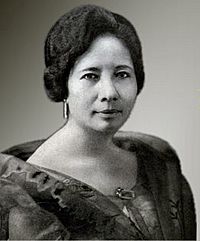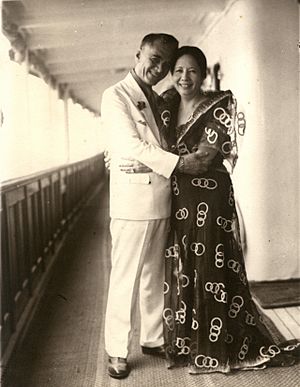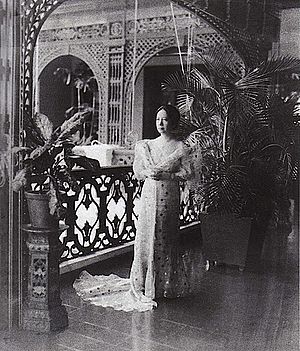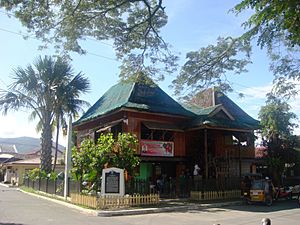Aurora Quezon facts for kids
Quick facts for kids
Aurora Aragon Quezon
|
|
|---|---|
 |
|
| Chairman of the Philippine Red Cross | |
| In office April 15, 1947 – April 28, 1949 |
|
| First Lady of the Philippines | |
| In role November 15, 1935 – August 1, 1944 |
|
| President | Manuel L. Quezon |
| Preceded by | Hilaria Aguinaldo |
| Succeeded by | Pacencia Laurel |
| Personal details | |
| Born |
Aurora Antonia Aragón y Molina
February 19, 1888 Baler, El Príncipe, Nueva Écija, Captaincy General of the Philippines |
| Died | April 28, 1949 (aged 61) Bongabon, Nueva Ecija, Philippines |
| Resting place | Quezon Memorial Shrine, Quezon City, Philippines |
| Spouse | |
| Children | 4 |
Aurora Antonia Aragon Quezon (born Aurora Antonia Aragón y Molina; February 19, 1888 – April 28, 1949) was the wife of Philippine President Manuel Luis Quezon. She served as the First Lady of the Philippines from 1935 to 1944. She was the first spouse of a Philippine president to be called "First Lady."
Many Filipinos loved Aurora Quezon. She was known for her work in helping others. She became the first chairperson of the Philippine National Red Cross. Five years after her husband passed away, she and her daughter María Aurora were killed. This happened while they were traveling to Baler to open a hospital named after President Quezon. The province of Aurora was named in her honor.
Contents
Early Life of Aurora Aragon Quezon
Aurora Aragón was born on February 19, 1888. Her parents were Pedro Aragón and Zenaida Molina. She was born in Baler, which was then part of Nueva Ecija. Her mother was of Spanish and Filipino heritage.
During the Philippine Revolution, her father was put in jail. He was suspected of being part of the Katipunan, a group fighting for independence. He later died while imprisoned. After this, Aurora was cared for by her aunt, María Dolores Molina. María Dolores was also the mother of Manuel Luis Quezon, who would become Aurora's cousin and future husband. Manuel also lived with the Aragón family when he was in Baler.
After her father's death, Aurora's family became very poor. They survived by growing their own food. This experience taught young Aurora to treat everyone equally, no matter their social standing. The family later moved to Lucena. Manuel Quezon was working there as a lawyer. Aurora wanted to be a teacher and studied at the Philippine Normal College in Manila. Manuel paid for her studies, but she had to stop after two years due to poor health.
Marriage and Family Life

In 1907, Manuel Luis Quezon was elected to the Philippine Assembly. By 1916, he became the president of the Philippine Senate. Aurora often visited Quezon in Manila. In December 1918, they got married in Hong Kong.
They had four children:
- María Aurora "Baby" (born 1919, died 1949)
- María Zeneida "Nini" (born 1921, died 2021)
- Luisa Corazón Paz (born 1924, died 1924)
- Manuel Lucio Jr. "Nonong" (born 1926, died 1998)
Sadly, Luisa died when she was a baby. Aurora was known as a loving wife and a strict but understanding mother. Manuel Quezon himself publicly called his wife "my friend, companion and partner." Their marriage lasted until Manuel's death in 1944.
First Lady of the Philippines

Manuel Quezon became a very important person in Philippine politics. In 1935, he was elected President of the Commonwealth of the Philippines. As First Lady, Aurora mostly stayed out of the political spotlight. She focused on women's groups, like the National Federation of Women's Clubs, where she was an honorary chairperson.
The Quezons were the first presidential couple to live in Malacañan Palace. However, Aurora preferred to spend time in a simple nipa house in Malacañang Park. She also enjoyed staying at her farm, Kaleidan, in Arayat, Pampanga.
She was an active First Lady. She strongly supported the movement to give Filipino women the right to vote, which happened in 1937. She also managed her family's farm in Arayat. She wanted to show how landlords and tenants could work together fairly. Aurora was also involved with the Girl Scouts of the Philippines and the Associación de Damas Filipinas, an orphanage in Manila. She was also the honorary president of another orphanage called White Cross.
President Quezon was re-elected in November 1941. But soon after, Japan invaded the Philippines in December. Aurora went with her husband to Corregidor in December 1941. President Quezon took his oath for his second term there. For two months, the Quezon family stayed in Corregidor. Even in difficult conditions, Aurora remained calm and attended daily mass.
In February 1942, they began a long journey through Australia to escape the Japanese. They wanted to set up the Government in exile of the Commonwealth of the Philippines in another country. They finally reached the United States in June 1942. While in exile, Aurora took care of her sick husband. He died in Saranac, New York, from tuberculosis on August 1, 1944. After his death, she moved to California. She and her daughters volunteered as nurses for the Red Cross.
Postwar Activities and Legacy
When Aurora Quezon returned to the Philippines, the Philippine Congress offered her a monthly pension. She refused the money. She explained that many war widows and orphans needed help more than she did. She felt she could not accept government help when so many others were suffering. This act showed why many Filipinos saw her as a kind and respected leader.
In 1947, with Aurora's strong support, the Philippine National Red Cross became an independent organization. She became its first Chairperson and held the position until her death. She was also named honorary vice-president of the Philippine Tuberculosis Society. She continued her civic work, including helping to rebuild the Antipolo Church. She received special awards and honorary degrees for her contributions.
Assassination
On April 28, 1949, Aurora Quezon left her home to travel to Baler. She was going to open the Quezon Memorial Hospital there. She had been warned about the trip because of rebel activities in Central Luzon. She said that the rebel leader, Luis Taruc, would not hurt her because of her age.
A group of thirteen vehicles, including two military jeeps, went with Quezon. In her car were her daughter "Baby," her son-in-law Felipe Buencamino, Quezon City mayor Ponciano Bernardo, and Major General Rafael Jalandoni. They were traveling on the Baler–Bongabon Road. Aurora's car was leading the group.
As her car drove on the mountain road, it was stopped by armed men. The men ignored pleas that Mrs. Quezon was in the vehicle. Gunfire suddenly erupted from the side of the road and from the mountains. It is believed that 100 to 200 armed men were part of the attack. Mrs. Quezon, her daughter, and Mayor Bernardo were killed right away. Her son-in-law was badly wounded and later died. The soldiers in the convoy soon arrived and fought the attackers. The attackers took valuables from the victims before running away. In total, twelve people from Quezon's group and ten attackers were killed.


People in the Philippines and around the world were shocked and saddened by the massacre. United States President Harry Truman said, "It was awful." A nine-day period of national mourning was declared. President Elpidio Quirino cried openly at the funeral. Aurora Quezon was buried at Manila North Cemetery. Her two surviving children, Manuel Jr. and Nini, were among the mourners. Aurora Quezon is one of three presidential spouses in the Philippines who were murdered.
It was widely believed that the Hukbalahap, a communist rebel group, was responsible for the killings. Luis Taruc, the Hukbalahap leader, denied that his group was responsible. However, after he surrendered in 1954, he was charged with the murder of Quezon and others. These charges were later dropped.
On April 28, 2005, Aurora Quezon's remains were moved. She was re-buried in a black tomb next to her husband's sarcophagus at the Quezon Memorial Shrine in Quezon City. President Gloria Macapagal Arroyo and the Quezons' only surviving child, Zenaida "Nini" Quezon-Avanceña, attended the ceremony.
Aurora Quezon's Legacy
The road from Quezon City to Manila was renamed Aurora Boulevard in her honor in 1951. In the same year, President Elpidio Quirino created the Aurora sub-province. This area included Baler and nearby places in Quezon Province. In 1978, Aurora became a separate province. Manuel and Aurora Quezon are the only husband and wife to have provinces in the Philippines named after them.
The Aurora Tower at the Araneta Center in Cubao was also named after her. Her most important contribution to education was Mount Carmel College of Baler. This Catholic school was founded in 1948 by American missionaries who came to Baler because she invited them.
The Concerned Women of the Philippines created the Aurora Aragon Quezon Peace Awards in 1988. This award honors people who work for peace. The Aurora A. Quezon Elementary School in Quezon City is also named for her. So is the town of Aurora in Zamboanga del Sur. It is also said that the 'Doña Aurora' flower (Mussaenda philippica) was named after her because she wished to have a flower dedicated to her.
See also
 In Spanish: Aurora Quezon para niños
In Spanish: Aurora Quezon para niños



